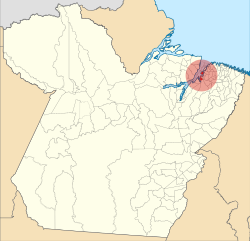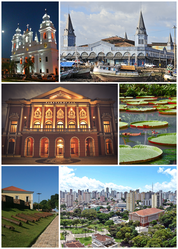Belém (Pará)
| Município de Belém Belém |
|||
|---|---|---|---|
|
|
|||
| Coordinates | 1 ° 28 ′ S , 48 ° 29 ′ W | ||
 Location of the municipality in the state of Pará Location of the municipality in the state of Pará
|
|||
| Symbols | |||
|
|||
| founding | January 12, 1616 | ||
| Basic data | |||
| Country | Brazil | ||
| State | Pará | ||
| ISO 3166-2 | BR-PA | ||
| Região intermediária | Belém | ||
| Região imediata | Belém | ||
| Metropolitan area | Belém metropolitan area | ||
| structure | 4 districts of the municipality | ||
| height | 10 m | ||
| Waters | Rio Maguari , Rio Guamá | ||
| climate | equatorial, Af | ||
| surface | 1,059.5 km² | ||
| Residents | 1,393,399 (2010) | ||
| density | 1,315.2 Ew. / km² | ||
| estimate | 1,492,745 (July 1, 2019) | ||
| Parish code | IBGE : 1501402 | ||
| Time zone | UTC −3 | ||
| Website | belem.pa (Brazilian Portuguese) | ||
| politics | |||
| City Prefect | Zenaldo Coutinho (2017-2020) | ||
| Political party | PSDB | ||
| Culture | |||
| Patron saint | Nossa Senhora da Nazaré | ||
| economy | |||
| GDP | 29,426,953 thousand R $ 20,350 R $ per person (2016) |
||
| HDI | 0.746 (2010) | ||
Belém ([ beˈlẽj ], German: Bethlehem, officially Portuguese Município de Belém ) is a large city in northern Brazil ; it is located on the Baía de Guajará, the confluence of the Rio Guamá in the Rio Pará and the Bay of Marajó . Belém is the capital of the state of Pará .
Within the metropolitan region of Belém (Grande Belém or Greater Belém), Belém (2019: around 1.49 million inhabitants) and the neighboring cities of Ananindeua and Marituba form the most populous metropolitan area of Pará with around 2.49 million inhabitants.
Belém is, next to Manaus , the most important city in the Brazilian Amazon . That of mango trees lined streets downtown Belém owes the nickname "Cidade das Mangueiras" (city of mango trees).
history
The Belém area originally belonged to the Tupinambá area.
Belém was founded on January 12, 1616 by the Portuguese captain Francisco Caldeira Castelo Branco. It was founded with the establishment of the Forte do Presépio fortress (known today as Forte do Castelo ) with the aim of defending the region against attempts at conquest by the English, French and Dutch.
The city was initially called Feliz Lusitânia . Then it was named Santa Maria do Grão Pará and Santa Maria de Belém do Grão Pará , until it received the current name Belém .
Far from the rest of the country and closely linked to Portugal , Belém did not recognize Brazilian independence until August 1823, almost a year after it was declared.
Between 1835 and 1840, Belém became the scene of the Revolta dos Cabanos uprising , also known as Cabanagem . This uprising is considered to be the one with the most authentic popular participation in the history of the country.
Due to the rubber boom , Belém achieved great economic importance at the end of the 19th and beginning of the 20th century. Magnificent buildings such as the Teatro da Paz (1878), Palácio Antônio Lemos, Palácio Lauro Sodré, Colégio Gentil Bitencourt and the Ver-o-Peso (1901) date from this period.
Population development of the city
| year | population |
|---|---|
| 1991 | 849.187 |
| 2000 | 1,272,354 |
| 2010 | 1,381,475 |
| 2019 | 1,492,745 |
Culture and sights
Although Belém is a bit off the usual tourist routes, there are some interesting buildings and facilities to visit:
theatre
Teatro da Paz, on the Praça da República. Built during the rubber boom , which is where many of the city's historic buildings stem from. The theater was renovated in 2001 and is now back in operation.
Museums and parks
Important museums are:
- Museu de Arte Sacra (religious art) with the former Jesuit church of São Alexandro
- Museu do Estado (changing exhibitions of contemporary artists)
- Museu das Onze Janelas (Brazilian artist of the 20th century)
- Zoological-botanical garden of the Museu Paraense Emílio Goeldi (park with Amazonian animal and plant species, anthropological and natural history exhibition, aquarium with Amazonian fauna)
- Bosque Rodrigues Álvez (park with aquarium and animal enclosures)
Other structures, markets and facilities
- Ver-o-Peso: fish and vegetable market. It is particularly worth visiting early in the morning when the boats are being unloaded. At the fish market you can admire the variety of Amazon fish species, elsewhere there are herbal stalls with natural remedies, some of which are said to have magical properties.
- The fish market building at Ver-o-Peso ("Look at the weight") is an iron structure designed by Henrique la Roque and built in 1901.
- Forte do Presépio: Fortress of Belém, with archaeological museum
- Catedral da Sé: old Belém Cathedral
- Palácio Antônio Lemos
- Palácio Lauro Sodré
- Residência dos Governadores: former governor's palace with a small park, restaurant and orchidarium
- Colégio Gentil Bitencourt
- Estação das Docas: former docks with restaurants and shops
- Presídio / Polo Joalheiro: newly established jewelry and handicraft center in a former prison.
- Engenho Murucutu: ruins of the sugar cane processing plant from the 18th century
- Small ceramic factories have settled in the Icoaraci district and make replicas of the Marajoara finds unearthed on Marajó
Universities and research institutions
Belém is the headquarters of two federal universities ( UFPA , UFRA ) and a state-sponsored university ( UEPA ). There are also private universities, e.g. B. UNAMA . The greater Belém area is also home to federal research institutes such as the Goeldi Museum , which is dedicated to the study of indigenous cultures and Amazonian ecosystems, and the Tropical Medicine Instituto Evandro Chagas (in Ananindeua ).
Regular events
The Círio (de Nossa Senhora) de Nazaré (since 1790), held every year on the second weekend in October, is the city's largest festival and is considered the largest religious festival in Brazil: up to two million people come to the city and carry a statue of Mary in one Litter from the cathedral to the basilica through the streets, attached to it is an approximately 400 meter long, strong rope. Whoever can grasp the regularly hard-fought rope (“ pegar a corda ”), is faithfully forgiven for sins; this custom has already led to serious accidents. The procession ships the statue of the Virgin Mary and accompanies her in decorated boats across the bay. On this day, children are given small painted boats and animal figures made of the light wood of the leaf stalks of the Buriti palm , which is why hordes of traders from the surrounding area flock to the city with toys they have built themselves.
In 2013, the "Círio de Nazaré" in Belém was in the Representative List of Intangible Cultural Heritage of Humanity of UNESCO entered.
Culinary specialties
The cuisine of the Belém region is rich in Indian influences. Typical dishes are:
- Maniçoba : Finely chopped green leaves of cassava -Pflanze with fatty meats and sausages (reminiscent of kale -dishes); is cooked for several days (traditionally a week) to that contained in the leaves of hydrocyanic acid to decompose
- Pato no Tucupi : Duck and Jambu vegetables, cooked in Tucupi
- Tacacá : broth made from tucupi, with salted prawns , jambú and goma ( manioc starch stirred into a jelly-like mass ),
- Açaí (pulp and juice of the berries of the cabbage palm Euterpe oleracea ): is u. a. served as a dessert
Roasted cassava flour (grated cassava root; farinha , seared and seasoned: farofa ) is omnipresent as a side dish , along with rice, black beans and various cold sauces with coriander leaves ( cheiro verde ), chopped tomatoes and onions or with peppers and other hot berries ( pimenta ). For dessert we recommend the sweet creams with pulp from Bacurí ( Platonia insignis , Clusiaceae ) and Cupuaçu ( Theobroma grandiflorum , Malvaceae ).
sons and daughters of the town
Archdiocese of Belém do Pará
climate
| Belém | ||||||||||||||||||||||||||||||||||||||||||||||||
|---|---|---|---|---|---|---|---|---|---|---|---|---|---|---|---|---|---|---|---|---|---|---|---|---|---|---|---|---|---|---|---|---|---|---|---|---|---|---|---|---|---|---|---|---|---|---|---|---|
| Climate diagram | ||||||||||||||||||||||||||||||||||||||||||||||||
| ||||||||||||||||||||||||||||||||||||||||||||||||
|
Average monthly temperatures and rainfall for Belém
Source: wetterkontor.de
|
|||||||||||||||||||||||||||||||||||||||||||||||||||||||||||||||||||||||||||||||||||||||||||||||||||||||||||||||||||||||||||||||||||||||||||||||||||||||||||||||||||||||||||||||||||||||||||||||||||
The climate is extremely warm with only minor fluctuations. The temperature rarely falls below 20 ° C.
literature
- Maik Sadzio: Turning of cultures: transcultural and transreligious identities. Evaluation of an empirical study among educational multipliers in Belém-Pará / Brazil . Norderstedt 2010, ISBN 978-3-8391-5006-1 ( uni-hannover.de [PDF]).
Web links
- City Prefecture website (Portuguese)
- City Council website (Portuguese)
- Map of Belém in OpenStreetMap
- POEMA - German aid program based in Belém
- Non-profit aid project for pottery families in Icoaraci (Belém)
Individual evidence
- ↑ a b c Belém - Panorama. In: cidades.ibge.gov.br. IBGE , accessed August 29, 2019 (Brazilian Portuguese).
- ↑ Zenaldo Coutinho 45 (Prefeito). In: todapolitica.com. Eleições 2016, accessed August 22, 2019 (Brazilian Portuguese).
- ↑ Círio de Nazaré (The Taper of Our Lady of Nazareth) in the city of Belém, Pará , accessed on November 24, 2014.






